Below are just a few of the theatres frequented during this period.
The Adelphia (aka Strand)
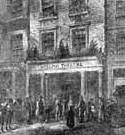 This theatre was originally built in 1806 as the "Sans Pareil" and was built by John Scott as a venue to show off his daughter's theatrical talents. It was renovated and reopened in 1819 as the Adelphi. The theatre's main patrons are the salaried clerks of barristers and solicitors. The Adelphi has the distinction of being the first to feature an adaptation of Charles Dickens. It's actually been through several renovations including a redesign just last year. Some of its well-known managers were Frederick Yates and comedian Ben Webster.
This theatre was originally built in 1806 as the "Sans Pareil" and was built by John Scott as a venue to show off his daughter's theatrical talents. It was renovated and reopened in 1819 as the Adelphi. The theatre's main patrons are the salaried clerks of barristers and solicitors. The Adelphi has the distinction of being the first to feature an adaptation of Charles Dickens. It's actually been through several renovations including a redesign just last year. Some of its well-known managers were Frederick Yates and comedian Ben Webster.
Known for its presentations of melodramas and dramatic adaptations including many of the works written by Charles Dickens, some of its features included:
| Tom and Jerry (Pierce Egan) | Life in London (T. W. Moncrieff) | ||
| The Christening (J. B. Buckstone) | The Peregrinations of Pickwick (W. L. Rede) | ||
| Nicolas Nickleby (Adaptation by F. Yates) | The Old Curiosity Shop (Adaptation by Edward Stirling) | ||
| A Christmas Carol (Adaptation by Edward Stirling) | The Haunted Man (Adaptation by Mark Lemon |
Astley's Amphitheatre
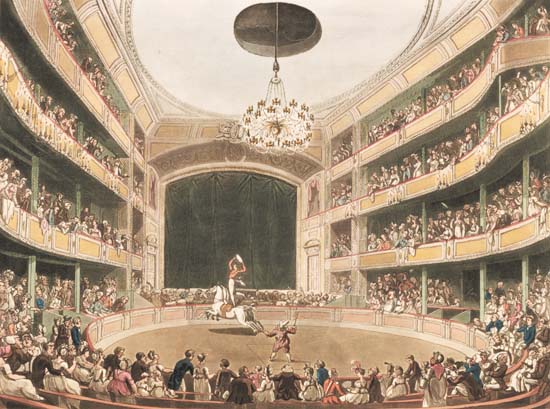 Philip Astley, a retired cavalry officer, after his second circus ring burned to the ground in 1803, built a new hippodrome. Here, under the management of Andrew Ducrow, many successful spectacular dramas were staged. in 1863, Boucicault renovated it and renamed it as The Theatre Royal, but the theatre failed. After being returned to its former name by E. T. Smith, the succeeding manager, the theatre reclaimed its fame with the equestrian adaptation of Byron's poem Mazeppa.
Philip Astley, a retired cavalry officer, after his second circus ring burned to the ground in 1803, built a new hippodrome. Here, under the management of Andrew Ducrow, many successful spectacular dramas were staged. in 1863, Boucicault renovated it and renamed it as The Theatre Royal, but the theatre failed. After being returned to its former name by E. T. Smith, the succeeding manager, the theatre reclaimed its fame with the equestrian adaptation of Byron's poem Mazeppa.
It was renamed again in 1872 by George Sanger who named it Sanger's Grand National.
The Britannia - High Street, Hoxton
 This colorful East end theatre is frequented by the working class and was built on the site of the Pimlico, an Elizabethan tavern attached to the Britannia Saloon. It was opened in 1843 by Sam Lane and continued to be managed by the Lane family for the balance of the century.
This colorful East end theatre is frequented by the working class and was built on the site of the Pimlico, an Elizabethan tavern attached to the Britannia Saloon. It was opened in 1843 by Sam Lane and continued to be managed by the Lane family for the balance of the century.
The Covent Garden
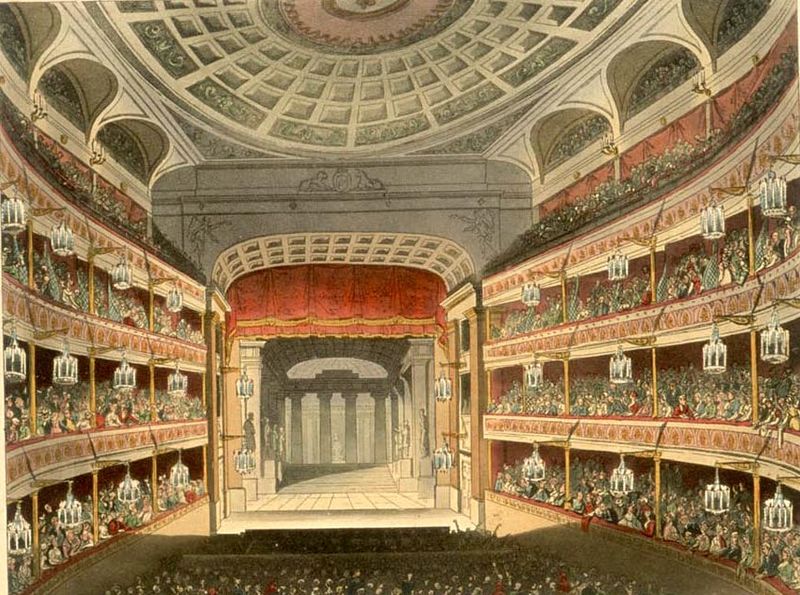 One of England's chief playhouses, managed by John Rich, the Covent Garden opened in December 1732 featuring Congreve's The Way of the World. Along with the Drury, it held the patent monopoly for legitimate drama. It was built with a capacity to seat 2,500 patrons, but the sight in several of the areas remained poor until its rebuilding in 1792. Under William Charles Macready, it became known for the revival of Shakespeare. The theatre was destroyed by fire in September 1808 and redesigned at a cost of £150,000 in a Neoclassical design. When the 1843 Theatre Regulation Act repealed the patent monopoly, the theatre declined and closed. It reopened in 1847 as the Royal Opera House. After a masque ball in 1856, the building again burned to the ground. Today stands the present day theatre dating from 1858 and designed by Sir Edward M. Barry.
One of England's chief playhouses, managed by John Rich, the Covent Garden opened in December 1732 featuring Congreve's The Way of the World. Along with the Drury, it held the patent monopoly for legitimate drama. It was built with a capacity to seat 2,500 patrons, but the sight in several of the areas remained poor until its rebuilding in 1792. Under William Charles Macready, it became known for the revival of Shakespeare. The theatre was destroyed by fire in September 1808 and redesigned at a cost of £150,000 in a Neoclassical design. When the 1843 Theatre Regulation Act repealed the patent monopoly, the theatre declined and closed. It reopened in 1847 as the Royal Opera House. After a masque ball in 1856, the building again burned to the ground. Today stands the present day theatre dating from 1858 and designed by Sir Edward M. Barry.
The Haymarket Theatre
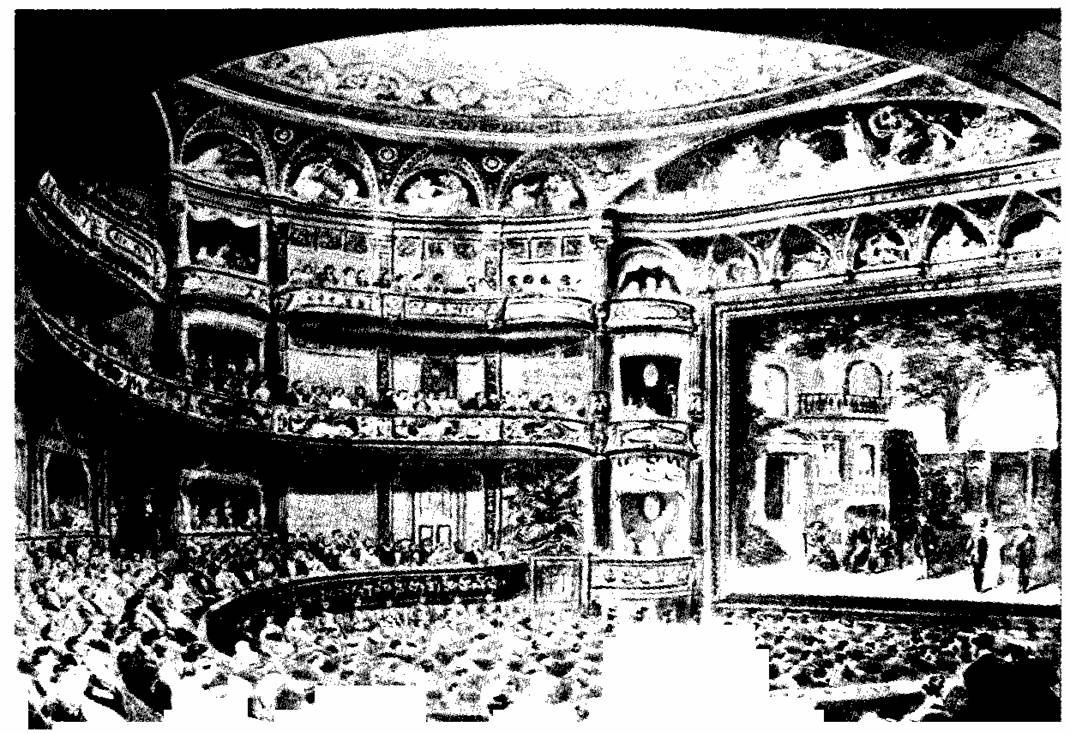 The "Little Theatre" in Haymarket, was built by John Potter in 1720. It's the second-oldest London playhouse and is still in use. Samuel Foot acquired the lease in 1747 and in 1766 gained a royal patent to play legitimate drama in the summer months. Many prominent actors were known to have their debuts here: John Henderson, Robert Elliston, Charles Matthews Sr. and John Liston. It was demolished in 1820 and rebuilt in 1821. It became known as a great comedy house under Webster and Buckstone's management.
The "Little Theatre" in Haymarket, was built by John Potter in 1720. It's the second-oldest London playhouse and is still in use. Samuel Foot acquired the lease in 1747 and in 1766 gained a royal patent to play legitimate drama in the summer months. Many prominent actors were known to have their debuts here: John Henderson, Robert Elliston, Charles Matthews Sr. and John Liston. It was demolished in 1820 and rebuilt in 1821. It became known as a great comedy house under Webster and Buckstone's management.
The Lyceum
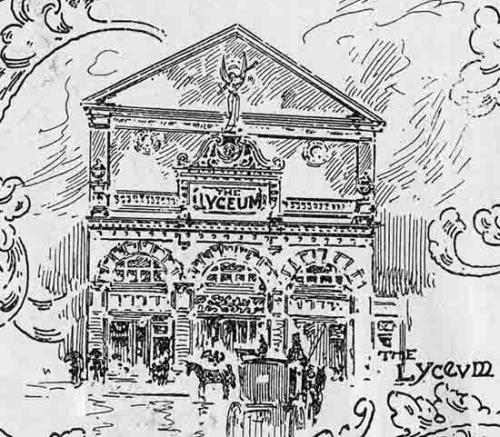 Built in 1765 originally to house exhibits and waxworks, the Lyceum did not become a "licensed" theatre until 1809. Samuel Arnold obtained permission to
stage opera and other musical drama and it was renamed "The English Opera House". It was rebuilt six years later and unfortunately was destroyed by fire in 1830.
Built in 1765 originally to house exhibits and waxworks, the Lyceum did not become a "licensed" theatre until 1809. Samuel Arnold obtained permission to
stage opera and other musical drama and it was renamed "The English Opera House". It was rebuilt six years later and unfortunately was destroyed by fire in 1830.
It was rebuilt and opened in July 1834 by Samuel Beazley. The Lyceum is associated with adaptations of Dickens's novels and Christmas Book. Stirling's adaptation of Martin Chuzzlewit ran for 105 performances between 1844 and 1845. Other famous works performed here included a Fairy Tale of Home an adaptation of Dickens' The Cricket on the Hearth; Albert Smith's adaptation of The Battle of Life and Tom Taylor's adaptation of A Tale of Two Cities.
Back to Intro/Index or Site Map
| | Family Gallery | Servants Parlour | Tour Home | Typical Day | Etiquette | Shopping Trip | |
| | Victorian Christmas | Victorian England Fun and Games | Ashton Library | Victorian Wedding | |
| | Victorian England Overview | Guest Registry | Honorary Victorian | Tours | |
| | Awards Received | Bibliography | |
| | 1876 Victorian England Home | |
Credits below copyright information |
| Contact
webmaster |
| Copyright
1999-2017 All Rights Reserved - B. Malheiro May not be reproduced in any way without express written permission of webmaster. |
Credits:
Background and buttons are the creation of webmaster, B. Malheiro. These images have been watermarked and are not for use on another site. Site authored by webmaster.
1. Irving as Stage Manager We Saw Him Act, ed. H. A. Saintsbury and Cecil Palmer (London 1939) p. 396.